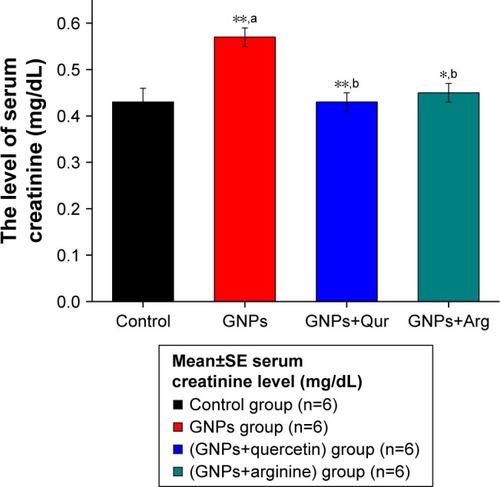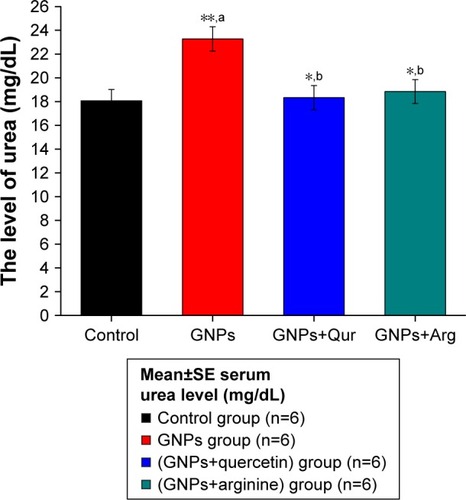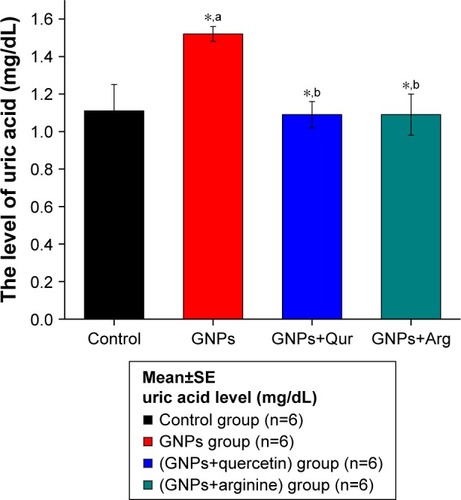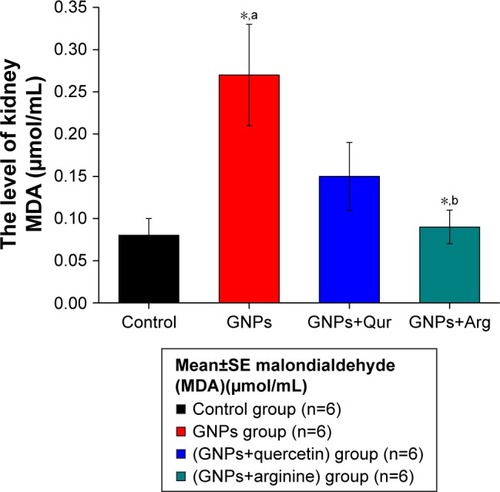Abstract
Introduction
This study aimed to evaluate the nephrotoxicity caused by gold nanoparticles (GNPs) and investigate the potential roles of quercetin (Qur) and arginine (Arg) in mitigating the inflammatory kidney damage and dysfunction and inhibiting the toxicity induced by GNPs in rats.
Methods
Kidney function was assessed using various serum biomarkers, including blood urea nitrogen (BUN), uric acid (URIC), and creatinine (CR), while toxicity was evaluated by measuring the biomarkers glutathione (GSH) and malondialdehyde (MDA) in kidney tissues.
Results
Administration of GNPs to the rats severely affected the serum kidney biomarkers, as confirmed by the notable increases in BUN, URIC, and CR. Substantial changes in the levels of the biomarkers MDA and GSH in the kidney tissues were also observed, with a reduced level of GSH and elevated MDA activity. The administration of Qur or Arg exerted a protective effect against GNP-induced inflammatory kidney damage and toxicity, but with different responses according to their evaluated normalized values.
Conclusion
This study demonstrates the beneficial effects of supplementation with Qur or Arg during the treatment with GNPs, potentially providing a powerful tool for cancer therapy.
Introduction
The use of nanoparticles (NPs) is not only restricted to the manufacturing industry and medical science, but it is also becoming increasingly common in consumer products.Citation1 The increased surface reactivity of NPs has been considered the main reason for their toxicity.Citation2,Citation3 The small size of NPs affords a large specific surface area and permits high affinity to be attained in biological systems. However, previous studies have indicated that increasing the surface area of NPs substantially promotes the generation of ROS.Citation4,Citation5
The shape and characteristics of gold nanoparticles (GNPs) make them promising materials for a broad range of biological applications. However, the application of GNPs in medicine and drug delivery requires a comprehensive understanding of their bioaccumulation and systemic toxicity. The kidneys are highly susceptible to xenobiotics owing to their extensive blood supply and capability to the toxins.Citation6,Citation7 Despite the numerous beneficial applications of GNPs, several studies have demonstrated that smaller GNPs cause greater cytotoxic and inflammatory responses compared with larger GNPs at the same mass concentration,Citation6,Citation7 owing to their high reactivity with biological components and the adverse effects induced by their enormous surface area and the large number of NPs.Citation6,Citation7
The toxicity of GNPs is influenced by their composition, nature of the functional surface, and shape and size.Citation6–Citation8 Exposure to GNPs may result in cardiac tissue damage, thickening and scarring of connective tissues, and long-term inflammatory cell infiltration, depending on the GNP size and period of exposure.Citation6–Citation8 These effects may originate from tissue damage due to the GNP toxicity, interactions of the GNPs with amino acids and enzymes, interference with the antioxidant resistance system, increased production of ROS, and induction of stress in kidney cells followed by necrosis.Citation6,Citation7
Quercetin (Qur) shields cells against oxidative stress and calcium dysregulation induced by hydrogen peroxide.Citation8 Arginine (Arg) is a conditionally essential amino acid that plays several important roles in the body, such as mitosis, wound healing, and defense against infectious substances.Citation9–Citation11
To the best of our knowledge, no studies into the prevention of the nephrotoxicity induced by small GNPs have yet been reported. The goals of this study were to confirm the occurrence of GNP-induced nephrotoxicity and evaluate the protective effects of Qur or Arg supplementation in mitigating the toxicity, lipid peroxidation, and oxidative stress caused by GNPs, in an effort to support the potential application of GNPs in cancer treatment.
Methods
GNPs and antioxidants
Ten-nanometer GNPs (MKN-Au-010; MK IPEX Corp, Divn MK Nano, Canada) with a spherical shape according to transmission electron microscopy (TEM) images were used in this study. The rats were intraperitoneally administered 50 µL of the 10 nm GNPs. The GNP dose was selected according to the results obtained in our previous studies,Citation6,Citation7 where we used 10, 20, and 50 nm GNPs and demonstrated that the smallest GNPs exhibited the highest toxicity in most of the organs of the rats, which was confirmed by histological investigations. Quercetin (Qur) and arginine (Arg) were purchased from Sigma-Aldrich Co. (St Louis, MO, USA). The Qur and Arg doses were 100 mg/kg body weight (BW)/day and 200 mg/kg BW/day, respectively, which were selected according to the previous studies.Citation12,Citation13
Animals
Twenty-four Wistar Kyoto rats (12-week-old males weighing 220–240 g) were obtained from the College of Pharmacy at King Saud University (KSU). The rats were placed in cages under stable conditions (22°C±5°C temperature, 55%±5% humidity, and 12-hour light/dark cycle). The rats were allowed free access to water and fed with standard diet chow. All of the procedures involving animals were approved by the ethics committee at KSU and strictly followed.
Experimental design
The rats were fasted for 24 hours prior to administration of the GNPs and then separated into four groups of six rats. The first group (G1) of rats was not administered GNPs, which served as a control. The second group (G2) of rats was administered a daily intraperitoneal dose of 50 µL of 10 nm GNPs for 7 days. The third group (G3) of rats was administered a daily intraperitoneal dose of 50 µL of 10 nm GNPs plus 100 mg/kg BW/day of Qur for 7 days. The fourth group (G4) of rats was administered a daily intraperitoneal dose of 50 µL of 10 nm GNPs plus 200 mg/kg BW/day of Arg for 7 days.Citation12,Citation13 We previously showed that histological changes in various rat organs are dependent on both the size of the GNPs and the duration of exposure, and these changes were observed after 7 days.Citation6
Blood sampling and tissue preparation
The rats were deprived of food for 12–14 hours, and the serum samples were centrifuged at 3,000 rpm for 10 minutes and stored at −80°C prior to analysis of the serum biomarkers. The kidney tissues were harvested via midline incision, rinsed with cold isosmotic saline, and homogenized with ice at −80°C prior to analysis of the tissue biomarkers.Citation13
Serum kidney function biomarkers
The blood urea nitrogen (BUN), creatinine (CR), and uric acid (URIC) values in the blood serum of the rats were assayed using a biochemical auto-analyzer (Type 7170; Hitachi Ltd., Tokyo, Japan).Citation13
Reduced glutathione (GSH) level
The GSH level in the kidney tissues was determined enzymatically using the revised technique reported by Griffith.Citation14 The kidney tissues were first homogenized in 0.2 M ice-cold perchloric acid containing 0.01% EDTA followed by centrifugation at 10,000 rpm for 5 minutes. To evaluate the GSH level, the same procedures used by Abdelhalim et al were applied.Citation13 The absorbance was measured at a wavelength of 412 nm after 120 minutes at a temperature of 30°C. The GSH activity was determined by comparing the difference in absorbance between the test solution and a glutathione standard.Citation13
Malondialdehyde (MDA) level
The MDA level in the kidney tissues of the test animals was determined spectrophotometrically as a lipid peroxidation biomarker index, as reported by Utley et al.Citation28 The tissues were weighed and then homogenized (10% w/v) in 0.15 M frozen potassium chloride (KOH) inside a Potter homogenizer equipped with a motor-driven Teflon pestle.Citation13 Samples (1 mL) of the tissue homogenate were incubated in a shaker at a temperature of 37°C for 2 hours. Aliquots (1 mL) of the supernatant were added to 1 mL portions of 0.67% (w/v) 2-thiobarbituric acid, and the resulting mixtures were placed in a hot water bath for 10 minutes, allowed to cool by adding 1 mL of distilled water. The absorbance was measured at a wavelength of 535 nm, and using the tetraethoxypropane, the MDA level was determined.Citation13
Statistical analysis
The results are presented as the mean±SE and were subjected to one-way ANOVA. The confidence level was assayed (*P<0.05 and **P<0.001) compared with the control rats (a) and the rats administered GNPs (b).
Results
shows that the serum CR level of the GNPs group (0.57±0.02 mg/dL) was higher than that of the control group (0.43±0.03 mg/dL). The GNPs+Qur and GNPs+Arg groups displayed significantly reduced serum CR levels of 0.43±0.02 mg/dL and 0.45±0.02 mg/dL, respectively. Thus, treatment of the rats with Qur or Arg in addition to the GNPs maintained the serum CR level near that of the control animals.
Figure 1 Effects of GNPs, GNPs+Qur, and GNPs+Arg on the serum creatinine levels of the rats.
Notes: aCompared with control group. bCompared with GNPs group. *P<0.05 and **P<0.01.
Abbreviations: Arg, arginine; GNPs, gold nanoparticles; Qur, quercetin; SE, standard error.

shows the serum BUN levels of the control, GNPs, GNPs+Qur, and GNPs+Arg groups. The serum BUN level of the control rats was 18.08±0.93 mg/dL. Following 7 days of intraperitoneal administration of the GNPs, the mean serum BUN level had increased significantly to 23.28±1.03 mg/dL (**P<0.01), reflecting a marked disturbance of the normal urea level, leading to renal damage. Supplementation with Qur or Arg significantly reduced the BUN levels to 18.52±0.88 mg/dL and 19.22±0.62 mg/dL, respectively.
Figure 2 Effects of GNPs, GNPs+Qur, and GNPs+Arg on the serum blood urea nitrogen levels of the rats.
Notes: aCompared with control group. bCompared with GNPs group. *P<0.05 and **P<0.01.
Abbreviations: Arg, arginine; GNPs, gold nanoparticles; Qur, quercetin; SE, standard error.

shows that the serum URIC level of the GNPs group (1.55±0.75 mg/dL) was higher than that of the control group (1.10±0.98 mg/dL). Supplementation with Qur or Arg significantly reduced the serum URIC levels to 1.10±0.45 mg/dL and 1.13±0.65 mg/dL, respectively.
Figure 3 Effects of GNPs, GNPs+Qur, and GNPs+Arg on the serum uric acid levels of the rats.
Notes: aCompared with control group. bCompared with GNPs group. *P<0.05.
Abbreviations: Arg, arginine; GNPs, gold nanoparticles; Qur, quercetin; SE, standard error.

shows that the GSH level in the kidney tissues of the GNPs group (24.20±0.02 µg/mL) notably decreased when compared with the control group (56.85±0.02 µg/mL). Supplementation with Qur (47.85±0.01 µg/mL) or Arg (46.47±0.02 µg/mL) almost restored the GSH to normal levels.
Figure 4 Effects of GNPs, GNPs+Qur, and GNPs+Arg on the kidney glutathione levels of the rats.
Notes: aCompared with control group. bCompared with GNPs group. *P<0.05 and **P<0.01.
Abbreviations: Arg, arginine; GNPs, gold nanoparticles; Qur, quercetin; SE, standard error.

shows that the MDA level in the kidney tissues of the GNPs group (0.27±0.03 µmol/mL) markedly increased compared with the control group (0.08±0.01 µmol/mL). Supplementation with Qur or Arg effectively decreased the MDA levels to 0.15±0.03 µmol/mL and 0.94±0.02 µmol/mL, respectively.
Discussion
It has been established that nanoparticles enter blood vessels and associated tissues that supply blood and then spread to the hepatocytes, spleen, and kidneys.Citation15,Citation16 The kidneys play an essential role in removing toxic substances from the body. The NPs absorbed in the blood vessels and the associated tissues (which the blood vessels supply) are discharged by renal clearance.Citation17,Citation18
Only a few researchers have reported the possibility of NPs being poisonous to the renal tubules and glomeruli.Citation4,Citation19 Kidney injury with structural, pathological, and cell-like modifications resulting in kidney failure caused by NPs has been reported.Citation20,Citation21 In this study, the intraperitoneal administration of GNPs in vivo was found to significantly increase the serum levels of CR, URIC, and BUN compared with the control group. Furthermore, administration of the GNPs resulted in a significant increase in the MDA level and a significant decrease in the GSH level in kidney tissues.
Both Qur and Arg were found to exert protective effects against these GNP-mediated changes, opposing the imbalance due to the creation of free radicals and interference with the antioxidant resistance system, suggesting that these antioxidants may have medical applications against the cell-like destruction by preventing the accumulation of ROS.Citation22
It has been established that Qur significantly decreases cytokine levels, suggesting its usefulness for decreasing transplant knock-back. These results may explain the previous findings that the administration of Qur decreased tubular damage and mitigated the increase in inflammatory cytokine levels.Citation23
In this study, Arg significantly attenuated the increase in the CR level caused by the injection of the GNPs. Arg is known to possess several important biological and defensive functions, which are mainly related to inflammation and oxidative stress.Citation24 It plays a protective role against inflammation and oxidative stress in various pathological settings.Citation22
Upon treatment with Qur, the serum nitrate level significantly decreased in the intoxicated animals. However, the increased nitrogen oxide level in the Arg-treated group was complemented by a notable increase in the kidney GSH content of the rats injected with GNPs. The group injected with GNPs displayed a noteworthy increase in the lipid per-oxidation biomarker MDA, which might be associated with the generation of free radicals and consequent destruction of renal tissue, as indicated by the increased levels of kidney function biomarkers.Citation25
In this study, the administration of GNPs significantly decreased the GSH level, whereas supplementation with Qur or Arg almost completely restored the GSH to normal levels. The antioxidant capacity of Qur is predominantly due to its ability to react with hydrogen peroxide,Citation26 and it also decreases platelet agglomeration and crosslinking by reducing hydrogen peroxide accumulation.Citation27 Qur may also decrease cyclosporine-triggered oxidative stress by restoring the activities of antioxidative enzymes including glutathione peroxidase and catalase, thus inhibiting the nephrotoxic activity of cyclosporine and the resulting renal destruction.Citation27
Owing to the established relationship between NPs and oxidative stress, one plausible consequence of GNP-induced oxidative stress is DNA destruction. ROS have been reported to combine with DNA molecules resulting in damage to both purine and pyrimidine bases as well as the DNA backbone.Citation25 Moreover, mitigation of oxidative stress by either Qur or Arg may also mediate their anti-inflammatory effects. The GSH level in kidney tissues decreased significantly after administration of GNPs, whereas treatment with either Qur or Arg restored the GSH level in kidney tissues, which was ascribed to the antioxidant ability of the two compounds.
It has been observed that Arg causes a significant increase in the MDA level and a decrease in the GSH content in rat cardiac tissues.Citation24 These findings support the present results where the two antioxidants significantly ameliorated kidney damage by increasing the cellular GSH level and reducing lipid per-oxidation and serum kidney biomarkers. These results were substantiated by histological examination of renal tissues, which revealed the breaking up of numerous glomeruli, renal tubules, and massive and average atrophy, including epithelial degeneration and necrosis. Co-administration of Qur or Arg alongside the GNPs greatly reduced the occurrence of most of these histopathological features.Citation24
These results demonstrate that GNPs may cause inflammatory kidney injury through the generation of inflammatory mediators. Therefore, protective agents that reduce the production of these inflammatory mediators could mitigate the renal destruction and prevent organ failure. As shown in this study, supplementation with Qur or Arg was useful for inhibiting the GNP-induced nephrotoxicity as well as the resulting kidney dysfunction and inflammatory damage.
The MDA level is the primary index of lipid peroxidation; MDA acts as a carcinogenic and mutagenic substance, and when it combines with DNA, it forms a compound containing deoxyguanosine, deoxyadenosine, and deoxycytidine.Citation25 This DNA destruction can activate signal transduction pathways, inducing apoptosis and ultimately resulting in cell death.Citation25 The supplementation of Qur or Arg to rats administered GNPs helped protect their kidneys from DNA damage. The results of this study indicate that the protective effects of Qur or Arg against oxidative stress, lipid peroxidation, and kidney inflammatory damage and dysfunction may be associated with their capacity to restore these parameters to their normal levels.
Conclusion
This study confirmed the nephrotoxic effects of GNPs, which induced significant increases in the serum levels of CR, BUN, and URIC as well as significant elevation of the MDA level and a reduction of the GSH level in kidney tissues. Supplementation with Qur or Arg successfully mitigated the nephrotoxicity and lipid peroxidation induced by the GNPs. Our results confirm the protective effects of Qur and Arg as highly potent antioxidants, as well as their ability to mitigate kidney dysfunction and shield kidney tissues against the effects of lipid peroxidation and oxidative stress.
Author contributions
MAKA devises and participated in designing the study. MAKA and HAYQ carried out the bench work of the research and analyzed the role of the antioxidants in nephrotoxicity, lipid peroxidation, and inflammatory kidney injury. MAKA, YA, MSA, and HAYQ were involved in the research design and statistical analysis of research data. All authors contributed to data analysis, drafting and revising the article, gave final approval of the version to be published, and agree to be accountable for all aspects of the work.
Acknowledgments
The authors would like to extend their sincere appreciation to the Deanship of Scientific Research at King Saud University for the funding of this research through the research Group Project No RGP-285.
Disclosure
The authors report no conflicts of interest in this work.
References
- van TasselKAGoldmanRThe growing consumer exposure to oxidative stress and mitochondrial damageEnviron Health Perspect200311145546012676598
- DonaldsonKTranLJimenezLACombustion-derived nanoparticles: a review of their toxicology following inhalation exposurePart Fibre Toxicol200521016242040
- ColvinVLThe potential environmental impact of engineered nanomaterialsNat Biotechnol200321101166117014520401
- MøllerPJacobsenNRFolkmannJKRole of oxidative damage in toxicity of particulatesFree Radic Res201044114619886744
- LiNSioutasCChoAUltrafine particulate pollutants induce nanotechnology in everyday product: regulating innovative technologies in light of lessons from the pastConnecticut Law Review2011442
- AbdelhalimMAJarrarBMRenal tissue alterations were size-dependent with smaller ones induced more effects and related with time exposure of gold nanoparticlesLipids Health Dis20111016321936889
- AbdelhalimMAGold nanoparticles administration induces disarray of heart muscle, hemorrhagic, chronic inflammatory cells infiltrated by small lymphocytes, cytoplasmic vacuolization and congested and dilated blood vesselsLipids Health Dis20111023322151883
- WangHJosephJAStructure-activity relationships of quercetin in antagonizing hydrogen peroxide-induced calcium dysregulation in PC12 cellsFree Radic Biol Med1999275–668369410490289
- WitteMBBarbulAArginine physiology and its implication for wound healingWound Repair Regen200311641942314617280
- WuGJaegerLABazerFWRhoadsJMArginine deficiency in preterm infants: biochemical mechanisms and nutritional implicationsJ Nutr Biochem200415844245115302078
- StechmillerJKChildressBCowanLArginine supplementation and wound healingNutr Clin Pract2005201526116207646
- Al-RasheedNMProphylactic Role of α-Lipoic acid and vitamin e against zinc oxide nanoparticles induced metabolic and immune disorders in rat’s liverEuropean Rev Med Pharmacology Sci20141818131828
- AbdelhalimMMoussaSQaidHThe protective role of quercetin and arginine against hepatotoxicity induced by gold nanoparticlesInt J Nanomedicine2018132821282529785108
- GriffithOWDetermination of glutathione and glutathione disulfide using glutathione reductase and 2-vinylpyridine analystBiochem1980106207212
- OberdörsterGMaynardADonaldsonKPrinciples for characterizing the potential human health effects from exposure to nanomaterials: elements of a screening strategyPart Fibre Toxicol200528816209704
- JainTKReddyMKMoralesMALeslie-PeleckyDLLabhasetwarVBiodistribution, clearance, and biocompatibility of iron oxide magnetic nanoparticles in ratsMol Pharm20085231632718217714
- BurnsAAViderJOwHFluorescent silica nanoparticles with efficient urinary excretion for nanomedicineNano Lett20099144244819099455
- SchipperMLIyerGKohALParticle size, surface coating, and PEGylation influence the biodistribution of quantum dots in living miceSmall20095112613419051182
- BérubéKBalharryDSextonKKoshyLJonesTCombustion-derived nanoparticles: mechanisms of pulmonary toxicityClin Exp Pharmacol Physiol200734101044105017714092
- SemmlerMSeitzJErbeFLong-term clearance kinetics of inhaled ultrafine insoluble iridium particles from the rat lung, including transient translocation into secondary organsInhal Toxicol2004166–745345915204761
- ChenZMengHXingGAcute toxicological effects of copper on engineered nanomaterialsNat Nanotechnol2007246947818654343
- Mostafavi-PourZZalFMonabatiAVessalMProtective effects of a combination of quercetin and vitamin E against cyclosporine A-induced oxidative stress and hepatotoxicity in ratsHepatol Res200838438539217927767
- HushmendySJayakumarLHahnABBhoiwalaDBhoiwalaDLCrawfordDRSelect phytochemicals suppress human T-lymphocytes and mouse splenocytes suggesting their use in autoimmunity and transplantationNutr Res200929856857819761891
- HuangCCTsaiSCLinWTPotential ergogenic effects of L-arginine against oxidative and inflammatory stress induced by acute exercise in aging ratsExp Gerontol200843657157718424033
- FaddahLMAbdel BakyNAAl-RasheedNMAl-RasheedNMFataniAJAtteyaMRole of quercetin and arginine in ameliorating nano zinc oxide-induced nephrotoxicity in ratsBMC Complement Altern Med2012126022551254
- SanhuezaJValdesJCamposRGarridoAValenzuelaAChanges in the xanthine dehydrogenase/xanthine oxidase ratio in the rat kidney subjected to ischemia-reperfusion stress: preventive effect of some flavonoidsRes Commun Chem Pathol Pharmacol19927822112181475527
- SatyanarayanaPSSinghDChopraKQuercetin, a bioflavonoid, protects against oxidative stress-related renal dysfunction by cyclosporine in ratsMethods Find Exp Clin Pharmacol200123417518111676225
- UtleyHGBernheimFHochsteinPEffect of sulfhydryl reagents on peroxidation in microsomesArchives of Biochemistry and Biophysics196711812932

